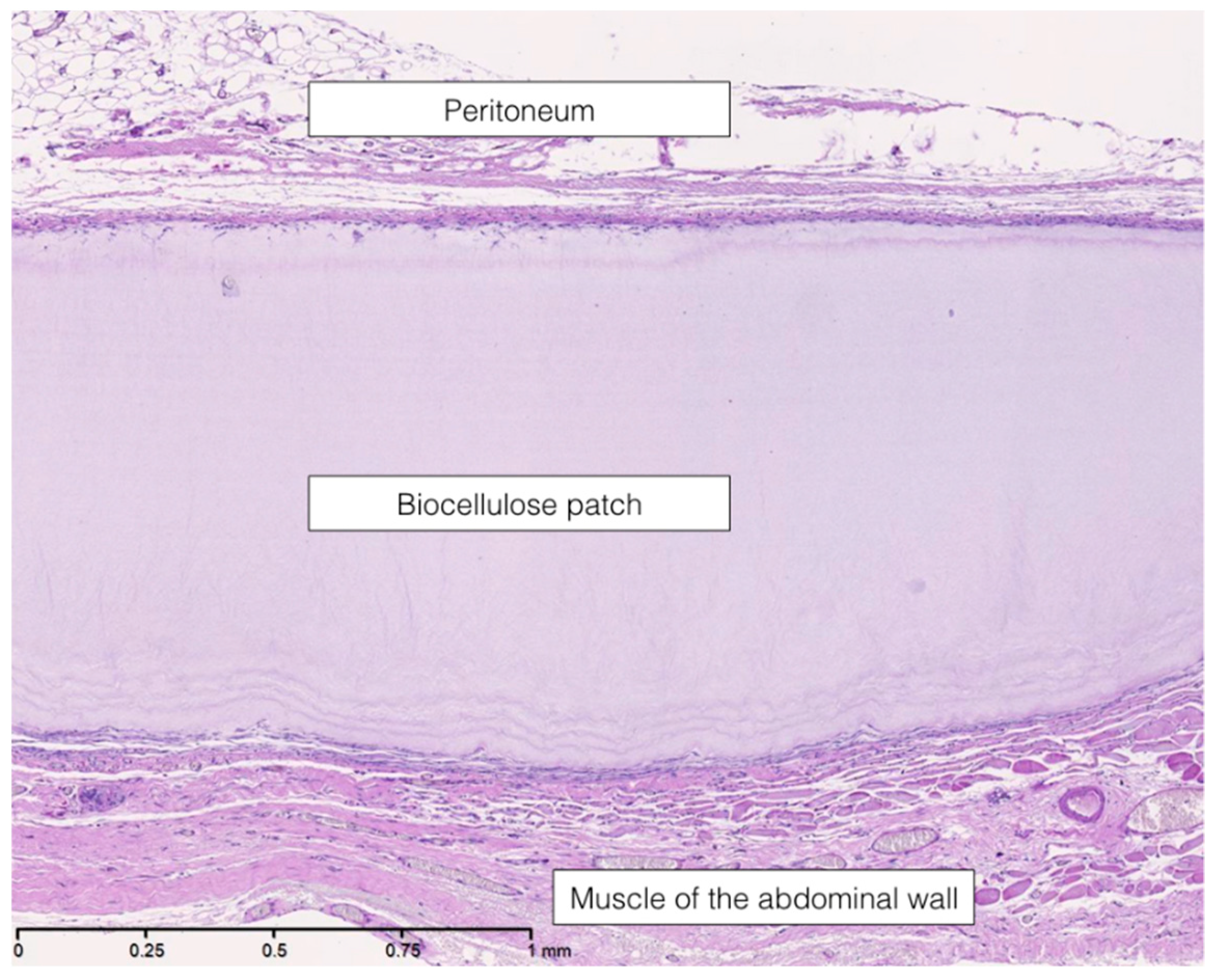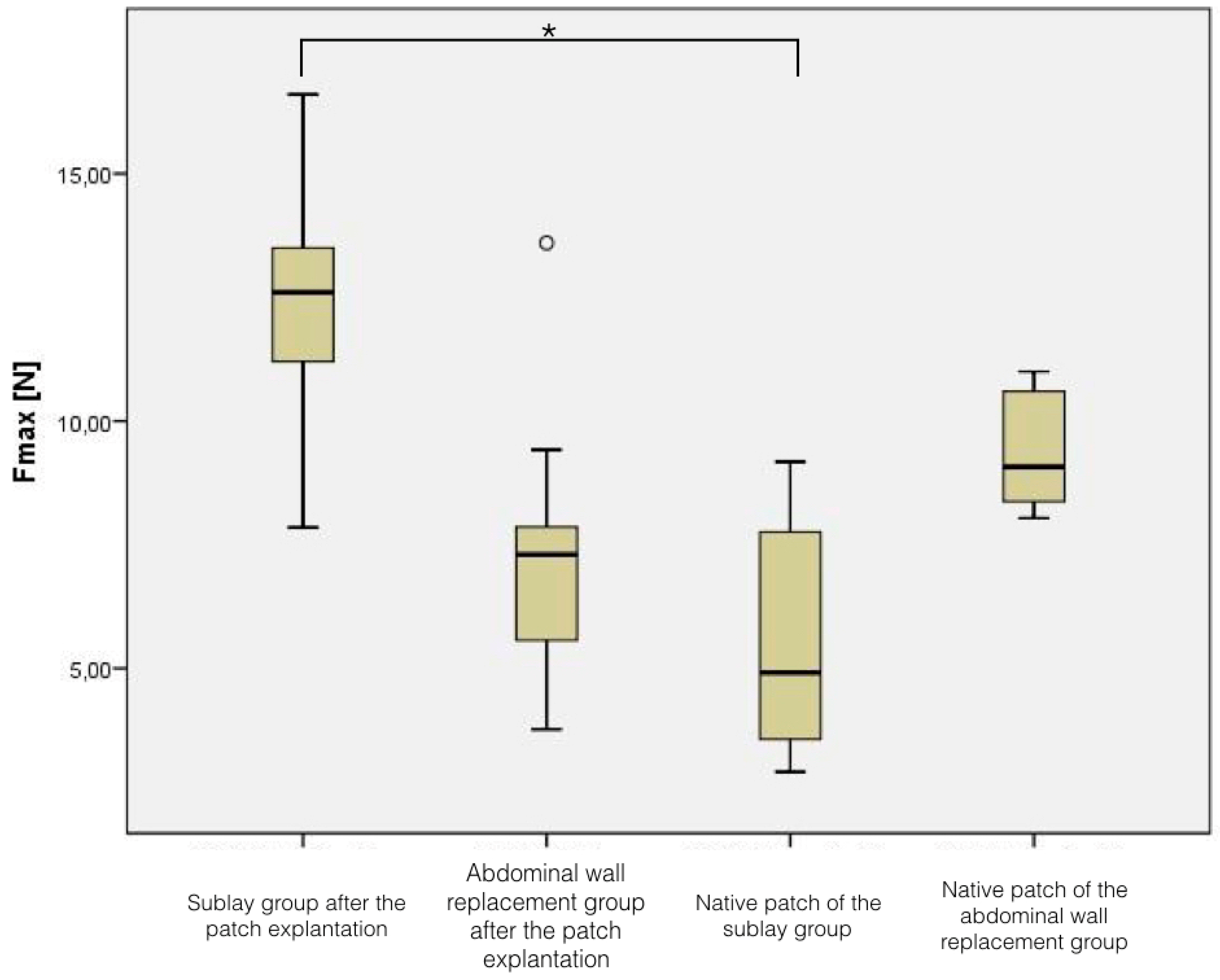Biocellulose for Incisional Hernia Repair—An Experimental Pilot Study
Abstract
:1. Introduction
2. Methods
2.1. Manufacturing of the BC Patches
2.2. Experimental Design
2.3. Sublay Technique:
2.4. Abdominal Wall Replacement:
2.5. Histologic Examinations
2.6. Tensile Testing
2.7. Statistical Analysis
3. Results
3.1. General Data
3.2. Adhesions
3.3. Material Shrinkage
3.3.1. Sublay Technique
3.3.2. Abdominal Wall Replacement
3.4. Histologic Examinations
3.4.1. Hematoxylin-Eosin Staining and Elastica-van-Gieson Staining
3.4.2. Naphthol-AS-D-Chloracetatesterase (ASDCL) Staining
3.4.3. Periodic Acid-Schiff Reaction
3.4.4. Bromdesoxyuridin (BrdU) Staining
3.5. Tensile Testing
4. Discussion
Author Contributions
Funding
Acknowledgments
Conflicts of Interest
References
- Hoer, J.; Fischer, L.; Schachtrupp, A. Laparotomy closure and incisional hernia prevention—what are the surgical requirements? Zentralbl. Chir. 2011, 136, 42–49. [Google Scholar]
- Chen-Xu, J.; Bessa-Melo, R.; Graca, L.; Costa-Maia, J. Incisional hernia in hepatobiliary and pancreatic surgery: Incidence and risk factors. Hernia 2018, 1–13. [Google Scholar] [CrossRef] [PubMed]
- Hernandez-Granados, P.; Lopez-Cano, M.; Morales-Conde, S.; Muysoms, F.; Garcia-Alamino, J.; Pereira-Rodriguez, J.A. Incisional hernia prevention and use of mesh. A narrative review. Cir. Esp. 2018, 96, 76–87. [Google Scholar] [CrossRef] [PubMed]
- Ventral Hernia Working Group; Breuing, K.; Butler, C.E.; Ferzoco, S.; Franz, M.; Hultman, C.S.; Kilbridge, J.F.; Rosen, M.; Silverman, R.P.; Vargo, D. Incisional ventral hernias: Review of the literature and recommendations regarding the grading and technique of repair. Surgery 2010, 148, 544–558. [Google Scholar] [CrossRef] [PubMed]
- Shankaran, V.; Weber, D.J.; Reed, R.L.; Luchette, F.A. A review of available prosthetics for ventral hernia repair. Ann. Surg. 2011, 253, 16–26. [Google Scholar] [CrossRef] [PubMed]
- Smart, N.J.; Bloor, S. Durability of biologic implants for use in hernia repair: A review. Surg. Innov. 2012, 19, 221–229. [Google Scholar] [CrossRef] [PubMed]
- Klemm, D.; Cranston, E.D.; Fischer, D.; Gama, M.; Kedzior, S.A.; Kralisch, D.; Kramer, F.; Kondo, T.; Lindström, T.; Nietzsche, S.; et al. Nanocellulose as a natural source forgroundbreaking applications in materialsscience: Today’s state. Mater. Today 2018, 21, 720–748. [Google Scholar] [CrossRef]
- Lang, N.; Merkel, E.; Fuchs, F.; Schumann, D.; Klemm, D.; Kramer, F.; Mayer-Wagner, S.; Schroeder, C.; Freudenthal, F.; Netz, H.; et al. Bacterial nanocellulose as a new patch material for closure of ventricular septal defects in a pig model. Eur. J. Cardiothorac. Surg. 2015, 47, 1013–1021. [Google Scholar] [CrossRef]
- Gruber-Blum, S.; Petter-Puchner, A.H.; Brand, J.; Fortelny, R.H.; Walder, N.; Oehlinger, W.; Koenig, F.; Redl, H. Comparison of three separate antiadhesive barriers for intraperitoneal onlay mesh hernia repair in an experimental model. Br. J. Surg. 2011, 98, 442–449. [Google Scholar] [CrossRef]
- Shubinets, V.; Carney, M.J.; Colen, D.L.; Mirzabeigi, M.N.; Weissler, J.M.; Lanni, M.A.; Braslow, B.M.; Fischer, J.P.; Kovach, S.J. Management of Infected Mesh After Abdominal Hernia Repair: Systematic Review and Single-Institution Experience. Ann. Plast Surg. 2018, 80, 145–153. [Google Scholar] [CrossRef]
- Kamarajah, S.K.; Chapman, S.J.; Glasbey, J.; Morton, D.; Smart, N.; Pinkney, T.; Bhangu, A. Systematic review of the stage of innovation of biological mesh for complex or contaminated abdominal wall closure. BJS Open 2018, 2, 371–380. [Google Scholar] [CrossRef] [PubMed]
- Moritz, S.; Wiegand, C.; Wesarg, F.; Hessler, N.; Muller, F.A.; Kralisch, D.; Hipler, U.C.; Fischer, D. Active wound dressings based on bacterial nanocellulose as drug delivery system for octenidine. Int. J. Pharm. 2014, 471, 45–55. [Google Scholar]
- Rosen, C.L.; Steinberg, G.K.; DeMonte, F.; Delashaw, J.B.; Lewis, S.B.; Shaffrey, M.E.; Aziz, K.; Hantel, J.; Marciano, F.F. Results of the prospective, randomized, multicenter clinical trial evaluating a biosynthesized cellulose graft for repair of dural defects. Neurosurgery 2011, 69, 1093–1104. [Google Scholar] [CrossRef] [PubMed]
- Scherner, M.; Reutter, S.; Klemm, D.; Sterner-Kock, A.; Guschlbauer, M.; Richter, T.; Langebartels, G.; Madershahian, N.; Wahlers, T.; Wippermann, J. In vivo application of tissue-engineered blood vessels of bacterial cellulose as small arterial substitutes: Proof of concept? J. Surg. Res. 2014, 189, 340–347. [Google Scholar] [CrossRef]
- Wippermann, J.; Schumann, D.; Klemm, D.; Kosmehl, H.; Salehi-Gelani, S.; Wahlers, T. Preliminary results of small arterial substitute performed with a new cylindrical biomaterial composed of bacterial cellulose. Eur. J. Vasc. Endovasc. Surg. 2009, 37, 592–596. [Google Scholar] [CrossRef] [PubMed]
- Tanaka, K.; Mutter, D.; Inoue, H.; Lindner, V.; Bouras, G.; Forgione, A.; Leroy, J.; Aprahamian, M.; Marescaux, J. In vivo evaluation of a new composite mesh (10% polypropylene/90% poly-L-lactic acid) for hernia repair. J. Mater. Sci. Mater. Med. 2007, 18, 991–999. [Google Scholar] [CrossRef] [PubMed]
- Petter-Puchner, A.H.; Fortelny, R.H.; Silic, K.; Brand, J.; Gruber-Blum, S.; Redl, H. Biologic hernia implants in experimental intraperitoneal onlay mesh plasty repair: The impact of proprietary collagen processing methods and fibrin sealant application on tissue integration. Surg. Endosc. 2011, 25, 3245–3252. [Google Scholar] [CrossRef]
- Falcao, S.C.; Coelho, A.R.; Evencio Neto, J. Biomechanical evaluation of microbial cellulose (Zoogloea sp.) and expanded polytetrafluoroethylene membranes as implants in repair of produced abdominal wall defects in rats. Acta Cir. Bras. 2008, 23, 184–191. [Google Scholar] [CrossRef]
- Falcao, S.C.; Evencio Neto, J.; Coelho, A.R. Incorporation by host tissue of two biomaterials used as repair of defects produced in abdominal wall of rats. Acta Cir. Bras. 2008, 23, 78–83. [Google Scholar] [CrossRef]
- Klemm, D.; Kramer, F.; Moritz, S.; Lindstrom, T.; Ankerfors, M.; Gray, D.; Dorris, A. Nanocelluloses: A new family of nature-based materials. Angew. Chem. Int. Ed. 2011, 50, 5438–5466. [Google Scholar] [CrossRef]
- Picheth, G.F.; Pirich, C.L.; Sierakowski, M.R.; Woehl, M.A.; Sakakibara, C.N.; de Souza, C.F.; Martin, A.A.; da Silva, R.; de Freitas, R.A. Bacterial cellulose in biomedical applications: A review. Int. J. Biol. Macromol. 2017, 104, 97–106. [Google Scholar] [CrossRef] [PubMed]
- Stumpf, T.R.; Yang, X.; Zhang, J.; Cao, X. In situ and ex situ modifications of bacterial cellulose for applications in tissue engineering. Mater. Sci. Eng. C Mater. Biol. Appl. 2018, 372–383. [Google Scholar] [CrossRef] [PubMed]
- Petter-Puchner, A.H.; Fortelny, R.H.; Walder, N.; Mittermayr, R.; Ohlinger, W.; van Griensven, M.; Redl, H. Adverse effects associated with the use of porcine cross-linked collagen implants in an experimental model of incisional hernia repair. J. Surg. Res. 2008, 145, 105–110. [Google Scholar] [CrossRef] [PubMed]
- Chelala, E.; Debardemaeker, Y.; Elias, B.; Charara, F.; Dessily, M.; Alle, J.L. Eighty-five redo surgeries after 733 laparoscopic treatments for ventral and incisional hernia: Adhesion and recurrence analysis. Hernia 2010, 14, 123–129. [Google Scholar] [CrossRef] [PubMed]
- Winny, M.; Maegel, L.; Grethe, L.; Lippmann, T.; Jonigk, D.; Schrem, H.; Kaltenborn, A.; Klempnauer, J.; Poehnert, D. Adhesion Prevention Efficacy of Composite Meshes Parietex®, Proceed® and 4DryField® PH Covered Polypropylene Meshes in an IPOM Rat Model. Int. J. Med. Sci. 2016, 13, 936–941. [Google Scholar] [CrossRef] [PubMed]
- Pott, P.P.; Schwarz, M.L.; Gundling, R.; Nowak, K.; Hohenberger, P.; Roessner, E.D. Mechanical properties of mesh materials used for hernia repair and soft tissue augmentation. PLoS ONE 2012, 7, e46978. [Google Scholar] [CrossRef] [PubMed]
- Helenius, G.; Backdahl, H.; Bodin, A.; Nannmark, U.; Gatenholm, P.; Risberg, B. In vivo biocompatibility of bacterial cellulose. J. Biomed. Mater. Res. A 2006, 76, 431–438. [Google Scholar] [CrossRef] [PubMed]






© 2019 by the authors. Licensee MDPI, Basel, Switzerland. This article is an open access article distributed under the terms and conditions of the Creative Commons Attribution (CC BY) license (http://creativecommons.org/licenses/by/4.0/).
Share and Cite
Rauchfuß, F.; Helble, J.; Bruns, J.; Dirsch, O.; Dahmen, U.; Ardelt, M.; Settmacher, U.; Scheuerlein, H. Biocellulose for Incisional Hernia Repair—An Experimental Pilot Study. Nanomaterials 2019, 9, 236. https://doi.org/10.3390/nano9020236
Rauchfuß F, Helble J, Bruns J, Dirsch O, Dahmen U, Ardelt M, Settmacher U, Scheuerlein H. Biocellulose for Incisional Hernia Repair—An Experimental Pilot Study. Nanomaterials. 2019; 9(2):236. https://doi.org/10.3390/nano9020236
Chicago/Turabian StyleRauchfuß, Falk, Julian Helble, Johanna Bruns, Olaf Dirsch, Uta Dahmen, Michael Ardelt, Utz Settmacher, and Hubert Scheuerlein. 2019. "Biocellulose for Incisional Hernia Repair—An Experimental Pilot Study" Nanomaterials 9, no. 2: 236. https://doi.org/10.3390/nano9020236
APA StyleRauchfuß, F., Helble, J., Bruns, J., Dirsch, O., Dahmen, U., Ardelt, M., Settmacher, U., & Scheuerlein, H. (2019). Biocellulose for Incisional Hernia Repair—An Experimental Pilot Study. Nanomaterials, 9(2), 236. https://doi.org/10.3390/nano9020236





